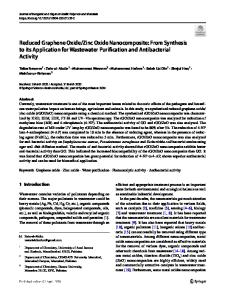Characterization of structural transformation of graphene oxide to reduced graphene oxide during thermal annealing
- PDF / 645,029 Bytes
- 8 Pages / 584.957 x 782.986 pts Page_size
- 65 Downloads / 418 Views
Characterization of structural transformation of graphene oxide to reduced graphene oxide during thermal annealing Iman Sengupta1, Suddhapalli S.S. Sharat Kumar1, Surjya K. Pal2, Sudipto Chakraborty1,a) 1
Department of Chemical Engineering, Indian Institute of Technology Kharagpur, West Bengal 721302, India Department of Mechanical Engineering, Indian Institute of Technology Kharagpur, West Bengal 721302, India a) Address all correspondence to this author. e-mail: [email protected] 2
Received: 23 December 2019; accepted: 20 February 2020
Graphene enticed the scientific community for its interesting properties since its discovery. Among different synthesis routes of graphene, reduction of graphene oxide (GO) is mostly preferred because of scalability and advantage of modulation of properties of the end product. Thermal reduction of GO is considered to be the simplest and economic among different reduction techniques. The current work reports an experimental analysis of the structural evolution of GO to reduced graphene oxide (rGO) during thermal treatment. GO has been thermally annealed at an optimized temperature of 350 °C in ambient. Thermal reduction is observed after 7 min of annealing and confirmed by shifting of the first major peak from 12° to 23° in X-ray diffraction pattern. Significant carbon content enrichment and exfoliation are two aspects of the thermal reduction of GO. Carbon content suddenly enriches from 38 wt% in GO to 77 wt%. Exfoliation is confirmed by morphological alterations and decrease in carbon layers from eleven to three.
Introduction 2
Graphene, a monolayer of a hexagonally arranged array of sp carbon atoms with its extraordinary electrical, optical, and mechanical properties, has become one of the most researched 2D nanomaterials in the recent past [1]. Although pristine graphene can be synthesized with bottom-up techniques such as chemical vapor deposition (CVD) [2, 3], they are associated with a considerable expense, and to date, scalable synthesis of graphene is a technological bottleneck for the practical application of such a multifunctional material [4]. Hence, a topdown approach by oxidation of graphite to graphene oxide (GO) and its reduction via various methodologies gained popularity as reduced graphene oxide (rGO) is almost alike graphene in terms of properties [5]. Among different GO reduction methods [6, 7, 8, 9, 10, 11, 12], thermal reduction is considered to be the most economical and most straightforward strategy to synthesize rGO. Thermal reduction of GO has been performed in different environments such as ambient [13], Ar–H2 and ultrahigh vacuum [14, 15], NH3–Ar [16], and N2 [17]. GO contains oxygen functionalities such as hydroxyl, carbonyl, epoxy on its basal planes, and carboxylic and
ª Materials Research Society 2020
hydroxyl groups in the edges [18, 19]. GO, when subjected to thermal treatment at sufficiently high temperature, undergoes structural change with the sudden exclusion of these functionalities. The sudden elevation of temperature creates shock on t
Data Loading...











